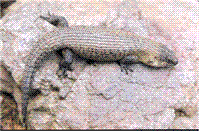Family
Scincidae (Skinks)
Genus
Egernia
Species
cunninghami
Threats/Control Methods - Regional
Much of the habitat of Cunningham's Skink is protected within parks and reserves, although further expansion of urban areas will probably have some impact on localised populations of the skink.
Threats/Control Methods - Local
Disturbance of the lizard's habitat by pets poses a threat to populations on the urban fringe.
Local/Urban Actions
Keeping pets away from rocky habitat areas is one step that Canberrans can take to assist populations of the skink.
Common name/s
Cunningham's Skink
Distinguishing Features
Cunningham's Skink varies in colour and pattern across its range. The lizard found in the Canberra region is brown to greenish brown above, with white speckles and dark blotches. The skink's body is broad and robust, as are the limbs. The toes have sharp claws, which are useful for climbing. Some scales on the back and tail are spiny. Cunningham's Skink is a moderately large lizard, which can grow to over 40cm, including tail, while usually averaging around 30cm.
Similar Species
Cunningham's Skink does not closely resemble any other lizards present in the ACT.
Distribution
The distribution of Cunningham's Skink stretches from south-eastern Queensland, through NSW and into Victoria, mainly on the slopes of the Dividing Range. An isolated population exists in the Mt Lofty Ranges of South Australia. In the ACT, skinks are able to inhabit areas up to 1000m.
Country of Origin
Australia
Survey Techniques
Hand searching is the method generally used in surveying these lizards.
Conservation (Pet/Pest) Status - National
Egernia cunninghami is not listed under the EPBC Act 1999
Conservation (Pet/Pest) Status - Regional
The skink is not considered a threatened species in the ACT.
LSCCES Population
The status of Cunningham's Skink in the local area is unknown.
Associated vegetation community
Grassland and woodland.
Limiting Resources
Availability of suitable shelter sites, especially rocky areas, limits the species distribution around the ACT.
Breeding
Live young are born in late summer, with the average litter size being five, with a maximum of eleven.
Behaviour
Shelters in crevices in boulder outcrops, cliff areas, tree stumps and fallen logs. Cunningham's skink is diurnal, and is often seen basking on granite boulders. The lizard is known to be social, often congregating in groups.
Functional Group
Omnivore.
Food Species
Fruits and seeds often form the main part of the adult diet, which is supplemented with insects and small vertebrates.
Predators
Cunningham's Skink is known to be preyed upon by elapid snakes.
Interesting Fact
Cunningham's Skink will often hide in crevices when threatened, where its spiny scales make it a difficult target for predators.
References - (reader suitability of references, P=Primary teachers, S=Secondary students, T=Tertiary students and researchers)
Books:
Bennett, R. 1997. Reptiles & frogs of the Australian Capital Territory, National Parks Association of the ACT, Woden. S, T
Cogger, H.G. 1996. Reptiles and Amphibians of Australia, Reed Books Australia, Melbourne. S, T
Swan, G., Shea, G. and Sadlier, R. 2004. A Field Guide to Reptiles of New South Wales, Second Edition , Reed New Holland, Sydney. S, T
Online Publications:
Greer, A.E. 2006. Encyclopedia of Australian Reptiles. Australian Museum Online, Version date: 7 August 2006. Thttp://www.amonline.net.au/herpetology/research/index.htm#encyclopedia [Last accessed 01/05/07]
Researcher: Ian Rayner

 Top
Top Top
Top